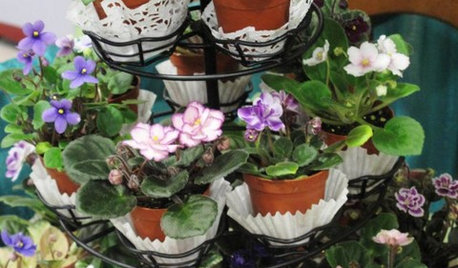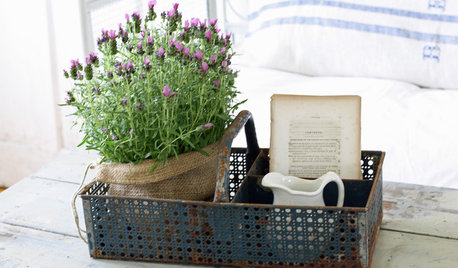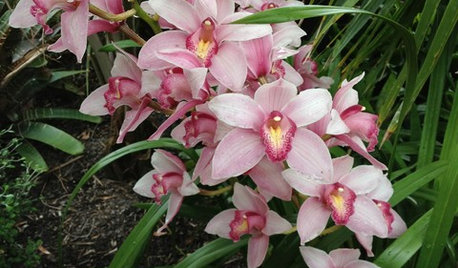Worm Castings in Houseplants
Jasdip
16 years ago
Featured Answer
Sort by:Oldest
Comments (15)
tapla (mid-Michigan, USDA z5b-6a)
16 years agobirdsnblooms
16 years agoRelated Discussions
Worm castings - or worms?
Comments (9)I find that my red worms who live outside do really well, so long as the soil is kept moist and they are fed often with vegetable/fruit trimmings. I often will add some partially composted leaves from my compost bin. Although, I find that they do well without much attention in my raised beds that have lots of organic compost, I like to keep one 4ft square bed that is shaded and kept covered with cardboard to add my veggie/fruit trimmings/composted leaves. I go clockwise around the bed to add food and to remove the vermicompost as needed to use in my containers/other beds. There are so many worms in the bed that is necessary to spread the vermicompost out to let it dry out and get the worms to move back to a moister section. Try to use unchlorinated water to moisten the rest of the bed or some that has sat out for 24hrs so that the chlorine has mostly evaporated. Red worms will eat the bacteria from the decaying foods, and I never have a problem with offensive odors ....actually, the compost in this bed smells really good and the plants seem to really thrive on it. I agree that getting these worms from someone in your area may be better as they will have adapted to your local weather conditions. I live in a desert area that has temps from the 20's to the 110's and they have survived many years outside this way....See MoreEarthworm castings versus Meal Worm castings?
Comments (2)kimmsr, Thanks for the link...I had been looking at growing mealworms for my chickens for added protein...great to know I can get poo from the beetles. Peggy...See MoreDo worm castings need to be fresh to make worm tea?
Comments (2)You can brew worm tea but I have found a better method. It takes months to make worm castings. I have 5 worm bins made from Kitty litter buckets and 2 inside bins (rubbermaid containers). I have a lot of potted plants and hated tossing the spent potting soil (expensive) into the garden. I have 2 compost tumblers and when the exothermic reaction is done I add worms to speed up the process. All bins are raised and have collecting trays. The drippage is the best worm tea. I collect it daily using a turkey baster,bulb syringe, or toomey syringe if you have one. You can collect the tea long before the castings and pour it on your potted plants. I have a 5 foot cilantro that really loved it and have brought back many nutrient deficient plants. Recycling potting soil in worm bins really works too and the worms love them....See MoreA new way of harvesting worm casts and separating worms?
Comments (2)Here's a hyperlink Here is a link that might be useful: Worm charming...See Moregreattigerdane
16 years agobcomplx
16 years agobirdsnblooms
16 years agoJasdip
16 years agobcomplx
16 years agoUser
16 years agotapla (mid-Michigan, USDA z5b-6a)
16 years agobcomplx
16 years agotapla (mid-Michigan, USDA z5b-6a)
16 years agoSuzy Q
6 years agotapla (mid-Michigan, USDA z5b-6a)
6 years agolast modified: 6 years agoKim McDonald
5 years ago
Related Stories

GARDENING GUIDESHouzz TV: Make a Worm Bin for Rich Soil and Happy Plants
A worm-powered compost bin that can fit under a sink turns food scraps into a powerful amendment for your garden. Here’s how to make one
Full Story
HOUSEPLANTSRetro Houseplants Get a New Look
The wild and crazy houseplants of the 1970s make a splash in today's interiors
Full Story
HOUSEPLANTSOutsmart Winter — Make Houseplants of Your Garden Growers
No need to watch Jack Frost play Wreck the Rosemary. Bring your garden inside for the winter, using containers and these guidelines
Full Story
HOUSEPLANTSMeet a Palm That's Fine With Fluorescent Light
Get the look of the tropics without the full-on sun and high humidity — parlor palm tolerates regular indoor conditions with aplomb
Full Story
DIY PROJECTSTurn a Wooden Pallet Into Unique Photo Frames
Free wood? We're so in. Salvage a pallet or other cast-off wood to make delightfully distressed frames that fit almost any decor
Full Story
HOUSEPLANTSIndoor Winter Gardens for Cheerier Days
Bring plants inside for drab-days mood boosting — not to mention cleaner indoor air and protection for your greenery
Full Story
FLOWERSOrchids 101: Cymbidiums Add Beauty Indoors and Out
Their large, long-lasting flowers give them a place of honor in homes and gardens
Full Story
DECORATING STYLESIs Your Home Ready for a 1970s Revival?
Seventies chic is a trend that’s been brewing for some time, but this year it could hit big — with a few modern tweaks
Full Story
DECORATING GUIDESKnot Again! Macrame Is Back
It's happened. A craft that typified 1970s style (the owls, the spider plants!) is back, but better
Full Story






Dave